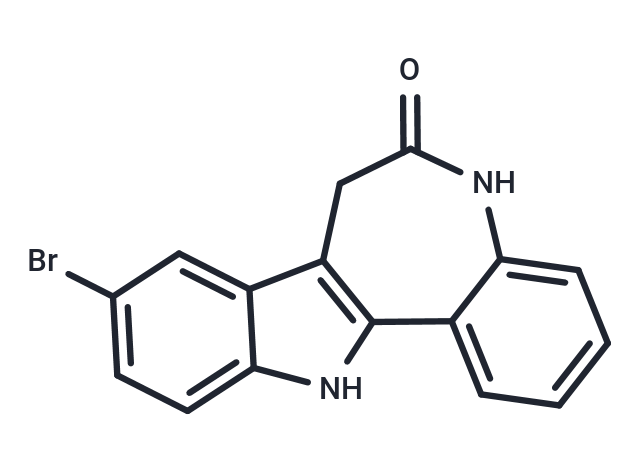Shopping Cart
Remove All Your shopping cart is currently empty
Your shopping cart is currently empty
KenPaullone (9-Bromopaullone), a potent CDK1, CDK2 and CDK5 inhibitor, as new enhancer for iTreg cell differentiation. Kenpaullone promotes iTreg cell differentiation through increased and prolonged transcription of foxp3 gene by enhancing TGFβ-Smad3 signaling pathway.

| Pack Size | Price | USA Warehouse | Global Warehouse | Quantity |
|---|---|---|---|---|
| 1 mg | $32 | In Stock | In Stock | |
| 2 mg | $45 | In Stock | In Stock | |
| 5 mg | $64 | In Stock | In Stock | |
| 10 mg | $96 | In Stock | In Stock | |
| 25 mg | $198 | In Stock | In Stock | |
| 50 mg | $336 | In Stock | In Stock | |
| 100 mg | $498 | In Stock | In Stock | |
| 500 mg | $1,130 | Inquiry | Inquiry | |
| 1 mL x 10 mM (in DMSO) | $68 | In Stock | In Stock |
| Description | KenPaullone (9-Bromopaullone), a potent CDK1, CDK2 and CDK5 inhibitor, as new enhancer for iTreg cell differentiation. Kenpaullone promotes iTreg cell differentiation through increased and prolonged transcription of foxp3 gene by enhancing TGFβ-Smad3 signaling pathway. |
| Targets&IC50 | CDK5-p35:0.85μM, ERK2:9 μM, ERK1:20 μM, CDK2-CyclinE:7.5μM, C-Raf:38 μM, CDK2-CyclinA:0.68μM, CDK1-CyclinB:0.4μM, GSK-3β:0.23μM |
| In vitro | In HEK-293 cells, phosphorylation of the endogenous GSK3α on Tyr279 is greatly decreased after prolonged incubation with Kenpaullone. Also, the Phosphorylation of the endogenous GSK3β also decreases, although less markedly. Kenpaullone also induces the dephosphorylation of both GSK3 isoforms in SH-SY5Y cells and PC12 cells. Kenpaullone (20 μM) strongly suppresses the autophosphorylation of GSK3β at Tyr216 in vitro whether GSK3 is expressed in Sf21 cells or in E. coli[2][3]. |
| Kinase Assay | IC50 determination: Active GST-LRRK2 (1326-2527), GST-LRRK2 [G2019S] (1326-2527), GST-LRRK2 [A2016T] (1326-2527) and GST-LRRK2 [A2016T+G2019S] (1326-2527) enzyme is purified with glutathione sepharose from HEK293 cell lysate 36 h following transient transfection of the appropriate cDNA constructs. Peptide kinase assays, performed in duplicate, are set up in a total volume of 40 μL containing 0.5 μg LRRK2 kinase (which at approximately 10% purity gives a final concentration of 8 nM) in 50 mM Tris/HCl, pH 7.5, 0.1 mM EGTA, 10 mM MgCl2, 20 μM Nictide, 0.1 μM [γ-32P]ATP (~500 cpm/pmol) and the indicated concentrations of inhibitor dissolved in DMSO. After incubation for 15 min at 30 °C, reactions are terminated by spotting 35 μL of the reaction mix onto P81 phosphocellulose paper and immersion in 50 mM phosphoric acid. Samples are washed extensively and the incorporation of [γ-32P]ATP into Nictide is quantified by Cerenkov counting. IC50 values are calculated with GraphPad Prism using non-linear regression analysis. |
| Synonyms | NSC-664704, 9-Bromopaullone |
| Molecular Weight | 327.18 |
| Formula | C16H11BrN2O |
| Cas No. | 142273-20-9 |
| Smiles | Brc1ccc2[nH]c-3c(CC(=O)Nc4ccccc-34)c2c1 |
| Relative Density. | 1.596 g/cm3 |
| Storage | Powder: -20°C for 3 years | In solvent: -80°C for 1 year | Shipping with blue ice/Shipping at ambient temperature. | ||||||||||||||||||||||||||||||||||||||||
| Solubility Information | Ethanol: 1.6 mg/mL (4.89 mM), Heating is recommended. DMSO: 41.67 mg/mL (127.36 mM), Sonication is recommended. | ||||||||||||||||||||||||||||||||||||||||
Solution Preparation Table | |||||||||||||||||||||||||||||||||||||||||
Ethanol/DMSO
DMSO
| |||||||||||||||||||||||||||||||||||||||||
| Size | Quantity | Unit Price | Amount | Operation |
|---|

Copyright © 2015-2026 TargetMol Chemicals Inc. All Rights Reserved.